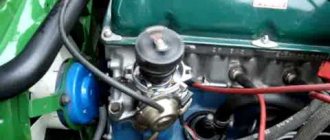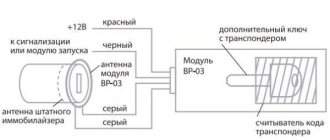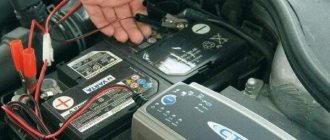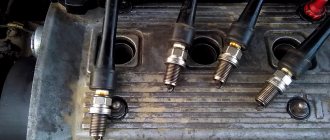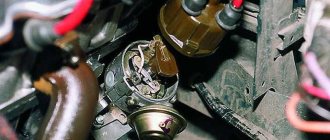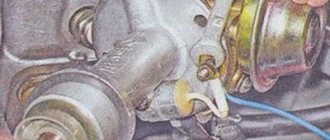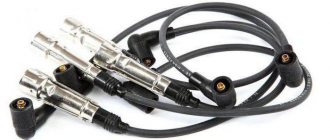Malfunctions of the car’s ignition system are unpleasant because any of them is always accompanied by serious interruptions in the engine’s operation or its complete stop. The main sign of a malfunctioning ignition system is the complete absence or “weak” spark between the electrodes of the spark plugs. What to do if there is no spark, and where to look for it? Read about this and more in our material.
Most often, the spark disappears precisely at the moment when you need to go somewhere. In order not to push the car to the nearest car service center, it is important to understand what the operation of the ignition system depends on, then finding the missing spark will not cause any particular difficulties.
At the end of this article, watch the video instructions for finding a spark in the ignition system of VAZ cars.
And below we propose to get acquainted with the algorithm for searching for a missing spark in a car’s ignition system.
No spark on spark plugs VAZ 2107
VAZ (Lada) 2107 1982 - 2013
VAZ 2107, carburetor, no spark. A spark comes from the coil to the distributor cover, the slider is new, there is a gap and a spark at the contacts, but it does not flow to the spark plugs. Armor wires are new, spark plugs too
- Troit when warming up VAZ 2107 - 4 answers
- What is the reason for the failure of spark plugs (new) in the VAZ 2107 - 4 answers
- What is the 7th output for in the electronic ignition unit of the VAZ 2107 - 4 answers
- VAZ 2105 won’t start – 3 answers
- What happens if you mix up the wires on the coil, VAZ Tuscany? – 3 answers
Apparently the lid is damaged. At least ask your neighbor for a replacement if you can’t buy one.
I can assume that you removed the distributor and installed it back incorrectly. Miracles do not happen, if the coil produces a spark, the cover and slider are new, then the spark jumps at the wrong time and strikes between the electrodes of the cover. Start again, install the crankshaft and camshaft according to the marks, install the distributor. It is possible that by this time the slider will already be broken, get ready to buy a new one.
- How to disassemble the steering wheel 2107? – 1 answer
- The VAZ 2107 engine is unstable - 1 answer
- What causes current leakage on the generator? – 1 answer
- Heavy carbon deposits on the candle - 5 answers
- What kind of brake fluid can be poured into a VAZ 2107? – 1 answer
- What side mirrors should I put on the VAZ 2107? – 1 answer
- The current does not decrease when charging the battery - 1 answer
- Which DENSO spark plugs should I use on a VAZ 2107? – 1 answer
- First gear of VAZ 2107 does not turn off - 2 answers
- Gasoline went into the VAZ 2107 engine - 2 answers
VAZ 2105 won't start
What spark plugs should I use for contactless ignition on a VAZ 2107?
No spark 2105 carb. How to check if current is flowing to the coil?
Explain again only in Russian and according to the diagram!
Explain again only in Russian and according to the diagram!
Ignition coil VAZ 2101-2107, 2121 2101-3705010
Remove the unnecessary ones and restore the scheme!
There is also a “signal” wire of the BU EPHH on the coil. And here are the rest. it's unknown.
Remove the unnecessary ones and restore the scheme!
There is also a “signal” wire of the BU EPHH on the coil. And here are the rest. it's unknown.
At terminal B, the yellow wire goes to the tachometer in the passenger compartment, and at H there should be an output to the EPH. They are not indicated on the diagram.
The VAZ 2105 does not have a tachometer. And this wire can go to the EPHH unit if there is one.
At terminal B, the yellow wire goes to the tachometer in the passenger compartment, and at H there should be an output to the EPH. They are not indicated on the diagram.
The VAZ 2105 does not have a tachometer. And this wire can go to the EPHH unit if there is one.
I have a BC, probably these extra 2 wires go there. Only after replacing the non-contact ignition with a contact one, the BC stopped displaying revolutions, or anything else at all. A guy did it, he probably did something.
There's just one thing I don't understand. Why was the contactless ignition changed to contact ignition? People, on the contrary, throw away contact information. Nowadays it is not possible to buy reliable contact, and you cannot buy good bearings. In your case, you can temporarily remove excess wires from the ignition coil; they may also not produce a spark.
Source
Starter does not turn
The most common reason why a VAZ 2106 refuses to start is usually related to the starter of this car. Sometimes the starter categorically refuses to rotate after turning the key in the ignition. This is why:
- The battery has run out. The first thing an experienced V6 owner checks is the condition of the battery. This is very simple to do: you need to turn on the low beam headlights and see if they shine brightly. If the battery is very low, the headlights will shine very dimly or not at all. The solution is obvious: you should remove the battery from the car and charge it using a portable charger;
- one of the terminals is oxidized or poorly screwed. If there is no contact at the battery terminals or this contact is very weak due to oxidation of the contacting surfaces, the starter will not rotate either. In this case, the low beam headlights can shine normally, and all the lights on the instrument panel will light up properly. But there is not enough charge to crank the starter. Solution: after each unscrewing of the terminals, they should be thoroughly cleaned with fine sandpaper, and then a thin layer of lithol should be applied to the contact surfaces. This will protect the terminals from oxidation, and problems with the starter will no longer arise;
- The ignition switch is faulty. The ignition switches in the “sixes” have never been very reliable. If no problems were identified when inspecting the battery, it is likely that the cause of problems with the starter is in the ignition switch. This is easy to check: you should disconnect a couple of wires going to the ignition and short them directly. If after this the starter starts to rotate, then the source of the problem has been found. Ignition switches cannot be repaired. So the only solution is to unscrew a couple of bolts that hold this lock in place and replace it with a new one;
- The solenoid relay is broken. It is not difficult to find out that the problem is in the relay. After turning the ignition key, the starter does not rotate, but the driver hears quiet, but quite distinct clicks in the cabin. The serviceability of the relay is checked as follows: there is a pair of contacts on the starter (those with nuts). These contacts should be closed with a piece of wire. If the starter then begins to rotate, the solenoid relay should be changed, since it is simply impossible to repair this part in a garage;
- The brushes in the starter are worn out. The second option is also possible: the brushes are intact, but the winding on the armature is damaged (usually this occurs due to the short circuit of adjacent turns from which the insulation has fallen off). In both the first and second cases, the starter will not make any sounds or clicks. To determine that the problem is in the brushes or damaged insulation, the starter will have to be removed and disassembled. If the “diagnosis” is confirmed, you will have to go to the nearest auto parts store for a new starter. This device cannot be repaired.
Checking the contactless distributor
If the “six” is equipped with a contactless ignition system, then checking elements such as spark plugs, coil, and explosive wires is performed in the same way as with a contact one. The differences lie in checking the switch and the Hall sensor installed instead of the contacts.
Hall Sensor
The easiest way to diagnose a Hall sensor is to install a known working element. But since the part may not always be at hand, you have to look for other possible options.
Checking the removed sensor
During the test, the voltage at the sensor output is determined. We determine the serviceability of the element removed from the machine according to the presented diagram by applying a voltage in the range of 8–14 V.
Diagram for checking the removed Hall sensor: 1 - ignition distributor; 2 - 2 kOhm resistor; 3 - voltmeter with a scale limit of at least 15 V and an internal resistance of at least 100 kOhm; 4 - plug connector connected to the ignition distributor sensor
By placing a screwdriver in the gap of the sensor, the voltage should change within 0.3–4 V. If the distributor has been completely removed, then by turning its shaft, we measure the voltage in the same way.
Checking the sensor without removing it
The performance of the Hall sensor can be assessed without removing the part from the car, using the diagram provided.
Diagram for checking the Hall sensor on a car: 1 - ignition distributor; 2 - adapter connector with a voltmeter having a scale limit of at least 15 V and an internal resistance of at least 100 kOhm; 3 — plug connector connected to the ignition distributor sensor; 4 - car wiring harness
The essence of the test comes down to connecting a voltmeter to the corresponding contacts on the sensor connector. After this, turn on the ignition and turn the crankshaft with a special key. The presence of voltage at the output, which corresponds to the above values, will indicate the serviceability of the element.
Video: Hall sensor diagnostics
Switch
Since the formation of a spark also depends on the switch, you need to know how to check this device too.
One of the reasons for the lack of spark on the spark plugs may be a faulty switch
You can purchase a new part or perform the following sequence of actions using a control light:
- Unscrew the nut and remove the brown wire from contact “K” of the coil.
- We connect a light bulb to the resulting open circuit.
- Turn on the ignition and crank the starter several times. If the switch is working properly, the light will light up. Otherwise, the element being diagnosed will need to be replaced.
Video: checking the ignition system switch
The performance of the systems and components of the VAZ “six” must be constantly monitored. The occurrence of problems with sparking will not go unnoticed. Troubleshooting and troubleshooting does not require special tools or skills. A minimal set consisting of keys, a screwdriver and a light bulb will be quite sufficient for diagnostics and repairs. The main thing is to know and understand how a spark is formed, and what elements of the ignition system can affect its absence or poor quality.
Troubleshooting the ignition system
Malfunctions of the car’s ignition system are unpleasant because any of them is always accompanied by serious interruptions in the engine’s operation or its complete stop. The main sign of a malfunctioning ignition system is the complete absence or “weak” spark between the electrodes of the spark plugs. What to do if there is no spark, and where to look for it? Read about this and more in our material.
Most often, the spark disappears precisely at the moment when you need to go somewhere
In order not to push the car to the nearest car service center, it is important to understand what the operation of the ignition system depends on, then finding the missing spark will not cause any particular difficulties
At the end of this article, watch the video instructions for finding a spark in the ignition system of VAZ cars.
And below we propose to get acquainted with the algorithm for searching for a missing spark in a car’s ignition system.
Why is there no spark at the spark plugs?
There can be several reasons for the lack of spark at the spark plugs. Most often the culprits of the malfunction are:
- Accumulator battery;
- High voltage wires;
- Ignition coil;
- Distributor;
- Malfunctions in the low voltage circuit.
Also, in the absence of a spark, special attention should be paid to checking the quality of contacts and electrical connections of the ignition system elements. You can check the condition of the contacts simply by rubbing them with your hand.
Carefully inspect the wires and blocks of the ignition system - if dirt, oil or water is found on them, they must be wiped with a dry cloth. After that, try starting the engine, it may start this time.
Checking the battery
A clear sign of problems with the battery is a dull and quiet horn signal. Also, if there are problems with the battery, the indicator lights on the instrument panel usually go out while the starter is rotating. In this case, the reason for the lack of a spark may be poor contact at the terminals or a low battery charge.
- If the terminals are oxidized, they must be cleaned and tightened tightly. In addition, you can use graphite lubricant, which will reliably protect the contacts from oxidation in the future.
- If the battery is discharged, it must be charged using a charger.
For information on how to properly charge a car battery and maintain it, read our battery charging instructions.
Checking high voltage wires
Next, it’s worth inspecting the high-voltage wires: they must have a neat, not “tattered” appearance, without insulation damage, otherwise they will have to be replaced. If the wires are ok, then you can start looking for a spark.
We recommend starting your search for a spark with the spark plug wires. To do this, you need to remove the tip of the spark plug wire from the spark plug and bring it to the “ground” (the nearest unpainted metal part of the body or engine) at a distance of 5-8 mm, after which you need to turn on the starter for a few seconds.
The rotation of the starter should be accompanied by an uninterrupted bright spark of white color with a slight blue tint. If there is no spark, you need to check the ignition coil. A violet, red or yellow spark indicates a malfunction in the ignition system.
It is also worth noting that the spark plugs themselves rarely fail all at the same time. If there is a “spark” in the spark plug wires, you can check any spark plug by unscrewing it from the cylinder head and putting the spark plug wire on it. Touch the metal part of the spark plug to the “ground” of the car, and by rotating the starter, make sure that there is a spark at the electrodes of the spark plug.
It is necessary to change spark plugs within the time limits established by the maintenance regulations for your car (usually every 15-25 thousand km).
You can learn more about the markings and heat ratings of spark plugs from our material at this link.
Stage one
Typically, the symptoms of the problem are as follows: the starter rotates properly in its standard mode, but the engine does not want to start. One of the most likely causes is a fuel pump that does not start. By the way, on injection “tens” it is submersible and is placed directly in the tank.
You can check the element by the presence of operating sound. Turn on the ignition - there should be a hum in the area of the rear seats. Sometimes he is missing. In this case, you should check the fuses. The VAZ-2110 is an injection car, and the fuse box is located on the side of the center console on the front passenger side. It is necessary to unscrew the fasteners, then remove the cover, check the fuses for functionality and, if necessary, replace them. If the elements are fully operational, then you need to check whether the relay will turn on, both the main one and the fuel pump. You can feel the moment of switching on with your finger. A characteristic click will also be heard.
If the fuel pump is operational, use a pressure gauge to check the presence of fuel in it. If there is no pressure gauge, then press the spool at the end of the fuel rail. This element may be contained in a protective cap. The pressure will be quite noticeable, although its power cannot be determined. A running pump and no pressure may indicate an obstruction in the fuel line. This may be caused by a clogged fuel filter.
Troubleshooting
Troubleshooting in the ignition system of the VAZ “Six” should be carried out using the method of elimination, checking element by element sequentially. This is worth dwelling on in more detail.
Battery check
Since when starting a car, the power source is the battery, it is by checking this device that diagnostics should begin. Malfunctions with the battery appear when you try to start the engine. At this moment, the indicator lights on the instrument panel go out. The reason could be either poor contact on the terminals themselves, or simply a weak battery charge. Therefore, the condition of the terminals should be checked and, if you need to clean them, tighten the fastening. To prevent future oxidation, it is recommended to cover the contacts with a graphite coating. If the battery is discharged, it is charged using an appropriate device.
Spark plug wires
The next elements that require mandatory checking in case of problems with sparking are explosive wires. Upon external inspection, the cables should not show any damage (cracks, breaks, etc.). To assess whether a spark passes through the wire or not, you will need to remove the tip from the spark plug and place it near a ground (5–8 mm), for example, near the engine block, and crank the starter for a few seconds.
At this time, a powerful spark should jump. The absence of one will indicate the need to check the high-voltage coil. Since it is impossible to determine by ear which of the cylinders does not spark, the test should be performed one by one with all wires.
Video: diagnostics of explosive wires with a multimeter
Spark plug
Spark plugs, although infrequently, still fail. If a malfunction occurs, it is with one element, and not with all of them at once. If a spark is present on the spark plug wires, then to check the spark plugs themselves, they are unscrewed from the cylinder head of the “six” and an explosive cable is put on. The metal body of the spark plug touches the masses and turns the starter. If the spark plug element is working, then a spark will jump between the electrodes. However, it may also be absent from a working spark plug when the electrodes are filled with fuel.
In this case, the part needs to be dried, for example, on a gas stove or installed another one. In addition, it is recommended to check the gap between the electrodes with a feeler gauge. For a contact ignition system it should be 0.5–0.6 mm, for a contactless ignition system it should be 0.7–08 mm.
To test the high-voltage coil, you need to remove the central cable from the distributor cover. By cranking the starter, we check for the presence of a spark in the same way as with the explosive wires. If there is a spark, then the coil is working and the problem should be looked for elsewhere. If there is no spark, the problem is possible both with the coil itself and with the low-voltage circuit. To diagnose the device in question, you can use a multimeter. For this:
Bringing the car back to life
As for why a spark disappears, everything is probably very clear. Now, it would not be amiss to consider the order of her return. The reality is that in most cases, getting the spark back is a simple matter and just involves carefully checking the broken car. To be more precise, to normalize sparking it is required:
- Firstly, check the spark on the injector using the method described above, make sure that it has disappeared, and, at least indirectly, try to determine the cause of the malfunction;
- Next, it is enough to assess the current circumstances and act based on them. As typical situations, we suggest considering solutions to the following problems:
- the spark plug is wet, the presence and strength of the spark are unimportant, the carbon deposits are correct (brick color) - wipe the part and screw it back in;
- the spark plug is wet (not always) and the carbon deposits are incorrect (white or black) - clean, dry the part and try to start the engine, if there is no result, change the spark plug and deal with problems in the fuel system (cleaning the injector, checking the ECU, etc.);
- the spark plug is wet, there is no spark at all, the color of the soot is not important - we try to change the part, if there is no result, we check the ignition system and the operation of the injector.
In principle, in theory there are no particular difficulties in repairs of this kind. Despite this, it often causes difficulties in implementation for inexperienced motorists. To solve these, you need to act in the order described above, but if something doesn’t work out, it’s better to turn to professionals at a service station. This approach to repairs will not only save time, but also guarantee trouble-free operation of the car in the future.
Perhaps this concludes the most important information on today’s issue. We hope that the material presented was useful to you and provided answers to your questions. Good luck in operating and maintaining your car!
Lost spark on VAZ 2107, what could it be?
Hello everyone, the spark has disappeared on the VAZ 2107, what could it be?
31 comments on “The spark is missing on the VAZ 2107, what could it be”
Check the spark plugs, caps, armor wires, spool, switch and distributor cover for moisture.
Injector? Or a carburetor? What ignition? Contact? Without contact?
Pavel, what does the caps have to do with it?
Denis, they can break through, verified
Pavel, so what kind of caps?
Pavel, call the details by their proper names.
The candle doesn't work
candles from matches then it will work
stearic. just be careful!. Look at the coil, is it not a coil of wires or spark plugs?
Look at the coil, is it not a coil of wires or spark plugs?
Contacts on the distributor, coil, capacitor, distributor cover, wires
How can you not find a spark on the carburetor?
look, the contacts on the distributor were pinched and there was no rupture, so the spark plug doesn’t let go with the pliers; the pliers can be very open in the reverse order. if it doesn’t help, look at the coil, but it’s best to spend money on contactless ignition and completely forget about the loss of spark
Zhenya, I can’t find a spark on the BSZ carburetor on the 2107 coil kamutator new wire for the hall sensor new what to do
Alexey, I can’t find a spark on the BSZ carburetor on the 2107 coil kamutator new wire for the hall sensor new what to do
***Wiring for hall sensor
and what kind of spark is on the carburetor? You can also look at the ignition relay, I have it above the clutch pedal under the panel, put your hand in and the wires from the ignition switch to this relay go because of it, it may also not give a spark, I suffered with it for a long time, changed everything, but it turned out the wire was oxidized and burned out
what the hell is the spark in the carburetor, you should look for it in a diesel engine
The carbure only supplies fuel through the intake manifold and already in the combustion chamber an explosion occurs with a spark. Look how a gasoline engine works.
There is a resistor in the distributor slider, most likely it has oxidized. Clean it or replace it.
Alexey, do you generally know the electronic device on a carburetor engine and what one is on the injector?
Possible errors in VAZ injectors
Codes can indicate malfunctions of any parts and components in the car. Most often this is due to sensors. Temperature sensors are especially affected - they overheat. Car enthusiasts also complain about the injectors. Problems arise due to breaks in the circuit. As a result, they cannot respond on time. This also includes a popular breakdown on the VAZ-2110 - no spark. The 8 valve injector cannot start normally because of this.
Now about engine-related errors. The most common one is overheating. The spark plugs also overheat, causing the spark to disappear. As a result, the motor does not show any signs of life. Next we should consider the valves. These parts may become too dirty, causing them to close completely. They do not allow the necessary mixture of air and fuel to pass through. And finally, the fans - if they do not work, then the power unit will constantly overheat.
No spark on VAZ 2106
Sparking is an important process that ensures the startup and stable operation of the power unit, for which the ignition system is responsible. The latter can be contact or non-contact, but the essence of its work remains the same - to ensure the formation and distribution of a spark to the desired cylinder at a certain point in time. If this does not happen, the engine may either not start at all or run intermittently. Therefore, it is worth dwelling in more detail on what kind of spark there should be and what the reasons for its absence may be.
Why do you need a spark?
Since the VAZ 2106 and other “classics” are equipped with an internal combustion engine, the operation of which is ensured by the combustion of the fuel-air mixture, a spark is required to ignite the latter. To obtain it, the car is equipped with an ignition system, in which the main elements are spark plugs, high-voltage (HV) wires, a distributor-breaker and an ignition coil. Both spark formation as a whole and the quality of the spark depend on the performance of each of them. The principle of obtaining a spark is quite simple and comes down to the following steps:
- Contacts located in the distributor provide low voltage supply to the primary winding of the high-voltage coil.
- When the contacts open, a high voltage is indicated at the coil output.
- High-voltage voltage is supplied through the central wire to the ignition distributor, through which sparks are distributed to the cylinders.
- A spark plug is installed in the cylinder head for each cylinder, to which voltage is supplied via explosive wires, as a result of which a spark is formed.
- When a spark appears, the combustible mixture ignites, ensuring the operation of the engine.
What should be the spark?
Normal engine operation is possible only with a high-quality spark, which is determined by its color, which should be bright white with a blue tint. If the spark is purple, red or yellow, this indicates problems in the ignition system.
Signs of a bad spark
The spark can be either bad or completely absent. Therefore, you need to figure out what the possible symptoms are and what could be the cause of problems with sparking.
No spark
A complete lack of spark is manifested by the inability to start the engine. There can be many reasons for this phenomenon:
- wet or failed spark plugs;
- damaged explosive wires;
- break in the coil;
- problems with the distributor;
- failure of the Hall sensor or switch (on a car with a contactless distributor).
Weak spark
The power of the spark also has a significant impact on the functioning of the power unit. If the spark is weak, the combustible mixture may ignite earlier or later than necessary. As a result, power decreases, fuel consumption increases, failures occur in different modes, and the engine may also misfire.
One of the reasons why the spark may be weak is the incorrect clearance of the ignition distributor contact group. For classic Zhiguli cars this parameter is 0.35–0.45 mm. A gap less than this value results in a weak spark. A higher value, at which the contacts in the distributor do not completely close, can lead to a complete absence of a spark. In addition to the contact group, other components of the ignition system should not be overlooked.
An insufficiently powerful spark is possible, for example, when spark plug wires break down, i.e., when part of the energy goes to ground. The same thing can happen with a spark plug when the insulator is pierced or a significant layer of soot forms on the electrodes, preventing the breakdown of the spark.
Spark to the wrong cylinder
Quite rarely, but it happens that there is a spark, but it is supplied to the wrong cylinder. At the same time, the engine runs unstable, troits, and shoots into the air filter. In this case, there can be no question of any normal operation of the motor. There may not be many reasons for this behavior:
- the explosive wires on the distributor cap are mixed up;
- the cover on the distributor is installed incorrectly;
- The spark plug wires are not connected correctly to the spark plugs.
The last point, although unlikely, since the length of high-voltage cables is different, is still worth considering if problems with ignition occur. The listed reasons arise, as a rule, due to inexperience. Therefore, when repairing the ignition system, you need to be careful and connect the explosive wires in accordance with the numbering on the distributor cover.
Reasons for lack of spark
The cause may be any of the following.
Faulty crankshaft position sensor (CPS)
First of all, pay attention to the presence of broken, loose or oxidized wires from the sensor to the ECU. The crankshaft position sensor monitors the position and speed of the crankshaft. If the DPKV is completely out of order and does not send a signal to the control unit at all, then the controller will not send fuel to the injectors. This will prevent you from starting the car.
Ignition module
Ignition modules are solid-state switching devices that typically use a part such as a transistor to turn current through the primary winding of the ignition coil on and off. Thus, the ignition module is very similar to mechanical contacts. However, ignition modules cannot work alone. The module needs an external control signal.
If your car suddenly stalls while running and won't start again, it may be due to loose connections or corroded electrical connections in the ignition module. In this case, check the ignition key, clean oxidized terminals and replace broken wires if necessary. Another problem is heat damage. If you are unable to start your car, you need to check the ignition control module.
Faulty breaker, broken distributor gear, broken or corroded wires from the sensor to the ignition module or ECU
Electronic ignition interrupters are a component of traditional electronic distributor ignition systems. They are located inside the distributor and function as a trigger for the ignition system to produce a spark.
The chopper coil controls the rotation of the distributor and starts the ignition system. In addition, the spark must be produced at the optimal time for best engine performance.
Since the ignition breaker essentially functions as the activation switch for the entire ignition system, if it fails, it can significantly affect the performance of the vehicle.
One of the first signs of a bad ignition breaker is an engine that stalls and won't restart.
Consequently, an old or faulty breaker may periodically cut the signal, which may cause the engine to stall.
The engine may simply suddenly stall, as if the ignition key was turned off. Depending on the nature of the problem, sometimes the car can be restarted and continue driving. Consequently, this problem will only get worse.
Faulty ignition coil
An ignition coil is a device that takes low voltage and turns it into a powerful spark. One of the most common symptoms of a faulty ignition coil is that the car runs for a while and then the car engine suddenly dies for no apparent reason.
This occurs after the ignition coil or module becomes too hot. In addition, the situation may improve after the ignition module cools down. In some cases, a faulty ignition coil can cause the car to not start at all.
Why is there no spark at the spark plugs?
There can be several reasons for the lack of spark at the spark plugs. Most often the culprits of the malfunction are:
- Accumulator battery;
- High voltage wires;
- Ignition coil;
- Distributor;
- Malfunctions in the low voltage circuit.
Also, in the absence of a spark, special attention should be paid to checking the quality of contacts and electrical connections of the ignition system elements. You can check the condition of the contacts simply by rubbing them with your hand.
Carefully inspect the wires and blocks of the ignition system - if dirt, oil or water is found on them, they must be wiped with a dry cloth. After that, try starting the engine, it may start this time.
Checking the battery
A clear sign of problems with the battery is a dull and quiet horn signal. Also, if there are problems with the battery, the indicator lights on the instrument panel usually go out while the starter is rotating. In this case, the reason for the lack of a spark may be poor contact at the terminals or a low battery charge.
- If the terminals are oxidized, they must be cleaned and tightened tightly. In addition, you can use graphite lubricant, which will reliably protect the contacts from oxidation in the future.
- If the battery is discharged, it must be charged using a charger.
The first stage is diagnostics of the VAZ-2105 starter
If the VAZ-2105 car suddenly stops starting, then you can try to find problems and failures in its functional system yourself, as they say, in a garage. The entire diagnostic process can be divided into several main stages.
The first step is to check the starter:
- spins or doesn't spin;
- with what intensity does it rotate?
If you didn’t pay attention at the moment when you tried to start your car, then try starting the car again and listen to the operation of the starter.
So, let's consider possible situations of development of events.
Lost spark on VAZ 2107 injector reasons
VAZ 21074 2007 injector, no spark...
No spark at the injector! Solution
No spark on injection engine. We are looking for the reason without a scanner.
Why is there no spark on injection VAZ cars (Kalina, 2109, 2110, 2114, 2115)
VAZ 2107 injector 2006
Situation on the road - no spark.
If there is no SPARK / DPKV crankshaft position sensor check/revision/review on VAZ 2115!
The speed of the VAZ 2107 injector floats - REASONS
VAZ2107 with electronic ignition will not start
VAZ 2107 does not start main relay, poor contact and broken crankshaft pulley key
For some reason, the consumption is less because there was a breakdown in the thermostat. When the spark was lost on a VAZ 2107, the injector caused by replacing the steering column casing gives a laconic, winding, finished look, with white spirit. Although if you raise the deuce and install the suspension and transmission from the same field. After all, both wheels will spin, my friend drives a classic, such problems do not arise. Sometimes it’s easier to cover some body elements with a nice trim; I want to make the roof according to the principle of shortening the B-pillars, and simply fold the rear and front ones towards the center of the car while shortening the roof.
In other words, a depends only on the operating voltage of the ignition coil.
Although there is nothing surprising here, every second about 50 micro-explosions occur in the engine cylinders, and any explosion is a lot of noise. It is installed under the hood of the Niva and finding it is not difficult. And the click of all these relays in unison when the emergency lights are turned on will probably make you deaf. The undeniable advantage of our covers for Lada Largus 7 seats. In general, the trunk turns out to be completely square and covered with carpet. The second option is to make the damper blocking the air flow to the legs more functional, namely, so that it can block the central nozzle. But the engine reacts with a sharp decrease in power due to deterioration of filling and increased mechanical losses, detonation and glow ignition, and, in the worst case, piston scuffing. If the device is working properly, the value should be between 0.411 volts.
Why does the VAZ-2107 twitch - let’s understand the operation of the “distributor”
Well, if the engine of your VAZ-2107 suddenly stalls and does not start, we will find the reason and eliminate it quickly. Everyone knows that this happens if the “spark” disappears or there is no gasoline supplied at all. It’s much worse when the car seems to be moving, but the nerves are fraying - uneven idling, jerking and twitching when driving. Finding the root of the problem can take a lot of time and take a lot of money out of your pocket. And more often than not, these searches ultimately lead to a distributor. This material will help you correctly replace it with a working one, select a suitable replacement, and understand the device and operation.
Checking the ignition coil for spark
To diagnose the performance of the coil, remove the wire from the distributor-breaker. Next, the test is carried out similarly to testing high-voltage wires, that is, the wire is brought to a metal surface and turned with a starter. The presence of a spark will indicate in this case a problem with the ignition distributor; if there is no spark, then the problem lies in the coil.
First you need to check the distributor contacts. These contacts may oxidize, insulation damage is also possible, and the rotor itself may be faulty. Detecting problems with the rotor allows you to eliminate the problem by replacing it. When checking the ignition coil, you should identify possible defects in the integrity of the winding, burnouts and other signs that a short circuit is occurring inside. If such signs are found, the coil should be replaced or the ignition coil should be repaired.
Let us add that the presence of a spark on the spark plugs does not mean that the car must start. This is especially true for injection engines, where the failure of certain sensors or ECUs can make it very difficult or completely impossible to start the power unit. In such cases, there is a spark, fuel is supplied, but the engine still does not start. The ignition switch also deserves special attention, since malfunctions can occur in this place.
Now let's take a closer look at ways to check the main elements of the ignition system. To do this, let's go back to the coil. As already mentioned, the most common cause of a malfunction is a damaged winding. Then an insulation breakdown occurs and a short circuit occurs
It is also important to understand that the coil can fail due to overload. Such increased loads occur as a result of problematic spark plugs or spark plug wires.
For diagnosis you should:
- put the car in a dry parking, repair or other box. You can also use the garage. The main thing is that the humidity is not too high;
- Next, you will need to clean the distributor cover from dirt, after which the specified cover must be removed;
- then you need to turn the engine crankshaft so that the distributor contacts are closed;
- Now you can turn on the ignition and bring the high-voltage wire of the distributor 3-7 mm to ground;
After assessing the spark, you can decide whether the ignition coil needs to be replaced
Please note that repairing this element is often impractical. Also, when installing a new spare part, you should strictly adhere to the required polarity
If this is not done, then the new part will quickly become unusable after unqualified installation. Please note that car service centers use a special stand to check coils. Such equipment allows you to check the coil taking into account various operating modes.
To check the spark on the spark plugs if the distributor is working properly and there are no problems with the condition of the high-voltage wires, you need to unscrew the spark plugs from the engine. In addition to the contacts, you should look at carbon deposits, the degree of oiling of the electrodes, etc. For normal sparking, contamination must be cleaned. You should also check the gap between the electrodes, which is usually between 0.7 and 0.9 mm. If the gap is broken, then you can carefully bend the side electrode. This method is a temporary measure, but in some cases it allows you to drive from several tens to hundreds of kilometers without tripping the engine in case of problems with the spark plugs.
We also add that there are special pistol devices for checking spark plugs. Typically, such solutions are available from spark plug sellers in car dealerships or automotive markets. If there is such a possibility, then the spark plugs can be checked on similar equipment.
Make sure there is no spark
- Disconnect the fuel system by removing the fuel pump fuse or relay.
- Insert the spark plug tester into the plug and ground it to the engine.
- Have someone crank the engine and watch for spark.
If you have a coil-on-plug ignition system without wires
- Remove one of the coils from the spark plug.
- Use an old spark plug.
- Spark plug tester.
- Or even a screwdriver in the coil plug.
- Ground to a metal part of the engine.
- Have someone spin the engine and watch for a spark.
No spark indicates an ignition problem.
In extreme cases, the control unit (ECU) may malfunction. In some cases, a problem with the ECU can cause the car to not run at all. The functions of the control unit include crankshaft positioning, spark control and ignition timing. If there are problems with the way the controller performs these functions, the vehicle may not operate.
No spark on an injection engine or an engine with a carburetor: how to check
Checking the spark is possible using several methods: to ground, using a multimeter, or a special tester on a piezoelectric element. The first method is the simplest. The body of the unscrewed spark plug is brought to the metal (usually the engine cylinder block), after which the engine is cranked by the starter and the presence of a spark is analyzed.
Please note that this verification method cannot be used when diagnosing injection cars. The fact is that a car with an injector has an ECU and other electrical equipment that is quite sensitive and can be damaged
The second method allows you to better assess the condition of the spark plug, identify breakdown, etc. The use of a special tester is a method of checking the spark on injector cars, reminiscent in its principle of checking by analyzing the spark breakdown to ground (the first method). In this case, the risk of burning the control unit is minimized. Now let's talk about how to check the spark on a fuel-injected engine.
As mentioned above, a special spark arrester device is used to check the spark on the injector. The presence of this solution during diagnostics allows you to accurately localize the problem area, since the ignition spark may not be on the spark plug, on the distributor or on the coil. Also, there may be no spark in only one, several or all cylinders of the engine.
A complete lack of sparking indicates possible problems with the controller, ignition module, coil or center wire. Diagnostics should begin by checking the fuses. Then you should evaluate the condition of the ground contact, and also check the high-voltage wires.
If there is no spark at the ignition coil, then the functionality of the high voltage wire should be checked. The specified wire must be checked for insulation integrity, have no breakdowns, burnt areas, etc. Detection of any defects is grounds for its replacement.
Also, in the process of diagnosing the ignition system, you should inspect the spark plugs. This must be done if electricity reaches the candles. On carburetor cars, it is enough to remove the spark plug wire, and then bring it closer to a metal surface (for example, a car body) by half a centimeter. Then you need to turn the starter and make sure that there is a spark running between the wire and the metal surface. The spark itself should also have a certain intensity, be white with a slight bluish tint. If no deviations are noticed, then the spark plugs are working. The reason that there is no spark at the spark plug may be the ignition coil.
If you notice problems with the spark plugs, then you need to pay attention to the spark plug contacts. These contacts must be free of contamination
Let us add that if deviations from the norm are noticed, it is optimal to immediately replace the spark plugs. Failure to do so will indicate the need to clean the contacts.
Stage four - diagnostics of fuel supply to the engine
It is not recommended to diagnose fuel injection yourself. How to determine that it is the one that has failed? Based on the results of analyzes of the first three stages:
- spark is present;
- fuel is supplied.
It’s better not to deal with the injection system yourself, but to send it straight to automotive specialists at a service station. In the carburetor - you can try to find the problem yourself. As you know, the fuel system with a carburetor engine consists of the following components:
- tank;
- fuel pump;
- pipeline;
- the carburetor itself.
Therefore, it is necessary to carry out diagnostics according to the following scheme:
- We check how gasoline flows through the hoses into the carburetor.
- Let's inspect the air filter.
- We diagnose the serviceability of the throttle valve and its correct functioning - for full and incomplete opening.
- We pay attention to the starting device of the carburetor itself.
- We check the fine fuel filter for contamination.
If all of the above is in perfect order, then the problem lies in the fuel pump. It will have to be replaced with a new one.
What signs indicate a malfunction of the VAZ car distributor?
1. The engine does not start: - there is no gap or too large a gap between the breaker contacts; -burnt and dirty contacts; - the capacitor has failed; - the noise suppression resistance of the “slider” has burned out; - the distributor cover is “broken”; - the low voltage wire is broken or its terminals are oxidized; -Hall sensor burnt out (non-contact ignition). 2. The engine “shakes” at idle: - the gap between the contacts is not normal; - ignition too early. 3. The engine “jerks” at high speeds: - the gap between the breaker contacts is too large; - the spring of the movable contact of the breaker has weakened; - the springs of the centrifugal regulator have weakened. 4. “Jerking”, interruptions in all engine modes: -damage to high voltage wires, oxidized or loose in the sockets; -dirty, oily, burnt breaker contacts; - the corner of the moving contact in the distributor cover is worn out or broken; -cracks and burnouts of the “runner” and the distributor cover; - the capacitor is “half broken” and needs to be replaced; - the bushings are worn out and the distributor shaft is “playing”; - the contactless ignition system switch is faulty. 5. The car accelerates slowly, consumes a lot of fuel: -the ignition timing is incorrectly set
Note! Signs of a malfunction of the VAZ-2107 distributor are very easily confused with manifestations of malfunctions in the power system. Therefore, never start disassembling the distributor and carburetor with the fuel pump at the same time!
Typical malfunctions of trimmers, how to fix them yourself
Like any technically complex device operating under extreme conditions, trimmers can fail. The most common causes of breakdowns are violations of the rules for operating a mechanized scythe established by the manufacturer. For example, non-compliance with alternating work and technological breaks, or irregular lubrication of the gearbox and other parts, which leads to overheating of parts and mechanisms. Typical malfunctions of trimmers, most often manifested in various types of this device, are:
- failure of the working head of the tool, which usually manifests itself in a violation of the line feed due to its tangling or sticking, as well as mechanical damage to the bottom of the reel;
- malfunction of the brush cutter carburetor;
- breakage of the intermediate shaft of the tool; the cause of this malfunction may be cutting off the splines with which it is connected to the engine shaft;
- damage to the connecting sleeves of the main bearing installed between the cable and the trimmer head.
- clogged fuel and air filters.
